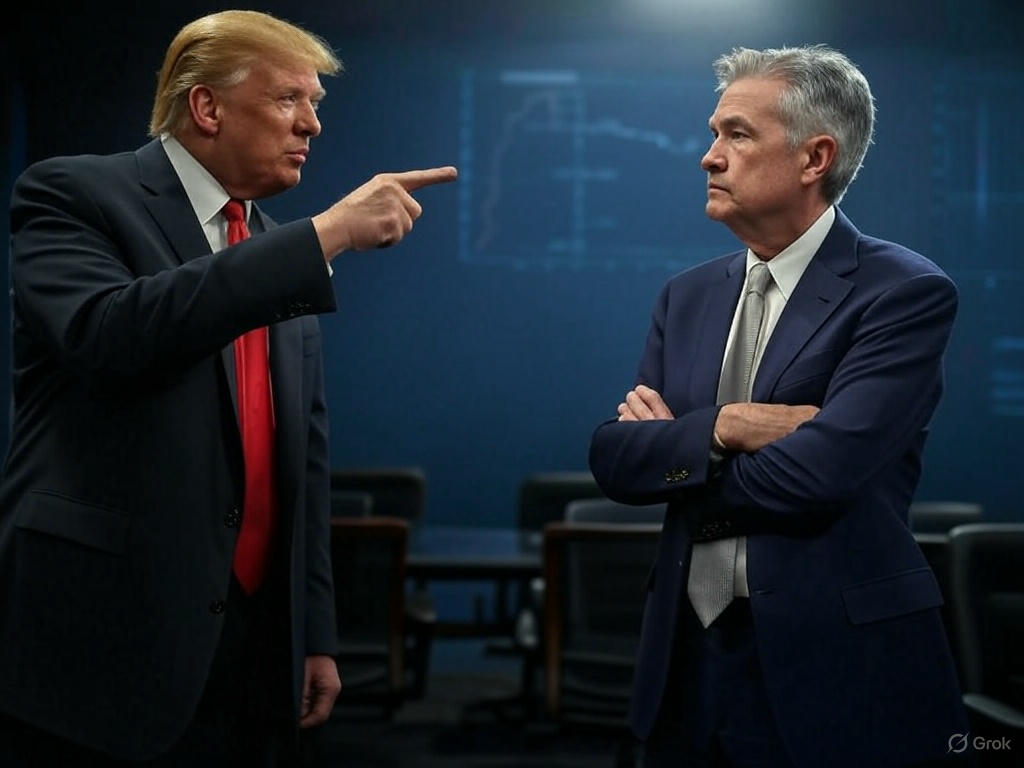Trump vs. Powell: The Hidden Battle Over Inflation and Interest Rates
Introduction: The Economic Showdown in 2025
The ongoing battle between President Donald Trump and Federal Reserve Chairman Jerome Powell is more than just political theater—it’s a fundamental clash over inflation, interest rates, and economic policy. Powell and the Fed argue that inflation is driven by strong economic growth, while Trump believes that excessive government spending is the real cause. Their differences could shape everything from Federal Reserve policy to stock market volatility in 2025.
For traders and investors, the stakes are high. If Powell sticks to his cautious stance, we may see higher interest rates for longer, creating market uncertainty. If Trump gets his way and forces rate cuts, it could trigger a market rally, though inflation risks remain. Either way, volatility is here to stay, making this showdown critical for anyone watching the markets.
The Federal Reserve’s Blind Spot: Ignoring Government Spending
 For years, the Federal Reserve (Fed) has framed inflation as a natural result of economic expansion. When consumer spending rises, businesses increase prices, and wages go up, inflation follows—or at least that’s the Fed’s traditional thinking. This perspective led to serious policy missteps during the post-pandemic recovery, when the Fed failed to anticipate the inflationary impact of massive government stimulus packages.
For years, the Federal Reserve (Fed) has framed inflation as a natural result of economic expansion. When consumer spending rises, businesses increase prices, and wages go up, inflation follows—or at least that’s the Fed’s traditional thinking. This perspective led to serious policy missteps during the post-pandemic recovery, when the Fed failed to anticipate the inflationary impact of massive government stimulus packages.
Between 2020 and 2021, the U.S. government injected over $5 trillion into the economy through stimulus checks, unemployment benefits, and business bailouts. This led to an explosion in consumer demand, with personal savings rates soaring to 33.8% in April 2020. As the economy reopened, businesses were overwhelmed by demand, but supply chains were still constrained. The result? Inflation surged to 9.1% by mid-2022, the highest in 40 years.
Despite these clear signals, the Fed largely downplayed the role of fiscal policy in driving inflation. Powell and his team focused on supply chain disruptions, labor market tightness, and strong consumer demand, rather than acknowledging that government spending had injected too much money into the system. Fast forward to 2025, and Powell is still repeating the same pattern. His March 19th comments on inflation focused on tariffs and a “solid” economy, while barely mentioning the impact of federal spending.
Trump’s Strategy: Cutting Government Spending to Curb Inflation
 Trump’s economic strategy is radically different. His administration, backed by the Department of Government Efficiency (DOGE)—led by Elon Musk and Vivek Ramaswamy—is focused on reducing federal spending by $2 trillion annually. The goal is to curb inflation by cutting government expenditures, rather than relying on high interest rates to slow down demand.
Trump’s economic strategy is radically different. His administration, backed by the Department of Government Efficiency (DOGE)—led by Elon Musk and Vivek Ramaswamy—is focused on reducing federal spending by $2 trillion annually. The goal is to curb inflation by cutting government expenditures, rather than relying on high interest rates to slow down demand.
DOGE’s primary mission is to eliminate waste and redundant government programs while modernizing federal operations. Musk has proposed moving government services to cloud-based infrastructure, which he claims could save billions. The administration is also targeting Medicare, Medicaid, and defense spending, arguing that these areas have grown inefficient and bloated.
Trump believes that if government spending is significantly reduced, inflation will decline naturally, allowing the Federal Reserve to cut interest rates without fear of another inflation spike. However, Powell remains skeptical, and the Fed has yet to factor these spending reductions into its inflation forecasts.
Trump vs. Powell: The Battle Over Interest Rates
Trump’s frustration with Powell is intensifying because the Fed has refused to lower interest rates, even as the administration takes aggressive steps to rein in spending. Powell maintains that inflation—projected at 2.8% (Core PCE) for 2025—remains too high, particularly due to Trump’s tariffs on Canada and Mexico (25% starting April 2025).
Trump argues that the Fed’s inflation model is flawed. He believes that lower government spending should reduce inflationary pressures, allowing for interest rate cuts without triggering another surge in prices. Powell, on the other hand, sees tariffs as inflationary and fears that cutting rates too soon could lead to renewed price increases, particularly if Trump’s tax cuts stimulate consumer demand.
This disagreement is creating major uncertainty in financial markets. If Trump pressures Powell into cutting rates, stocks could rally, but if Powell holds firm, interest rates may stay elevated longer than expected. The result? Continued volatility in equities, bonds, and commodities.
Does Trump Have a Point on Interest Rate Cuts?
Trump’s case for rate cuts makes sense in a specific context. If DOGE succeeds in reducing $2 trillion in spending, inflationary pressures could ease, giving the Fed room to lower rates without fueling another price surge. However, there are risks.
If Trump’s tax cuts significantly boost consumer spending, the inflationary effects of reduced government spending could be offset. Similarly, if tariffs increase costs for businesses, those expenses may be passed on to consumers, leading to higher prices despite budget cuts. Powell’s hesitation, while frustrating to Trump, is rooted in these concerns.
What This Means for Traders and Investors
For 0DTE (zero days to expiration) traders, the Trump-Powell feud is a gift. Market volatility is increasing, creating profitable opportunities in options trading.
• If Powell resists Trump’s push for rate cuts, expect more market uncertainty and larger intraday swings, which benefits traders who thrive on volatility.
• If Trump successfully pressures Powell into lowering rates, markets could experience a strong upward move, creating opportunities for trend-following strategies.
• DOGE’s success—or failure—will be a key factor in inflation forecasts, meaning traders must stay informed about spending cuts and fiscal policy shifts.
Conclusion: Volatility Is Our Ally
The Trump-Powell standoff over inflation and interest rates is far from over. Trump’s push for spending cuts and Powell’s cautious approach to rate reductions will keep markets on edge, making volatility a defining feature of 2025.
For traders, this presents exciting opportunities to capitalize on market swings. Whether rates stay high or begin to drop, the key will be staying ahead of policy changes and reacting to shifts in economic sentiment.
As this economic showdown continues, traders who adapt to the uncertainty will thrive.
Coach Ernie out. 🚀



 For years, the
For years, the  Trump’s economic strategy is radically different. His administration, backed by the
Trump’s economic strategy is radically different. His administration, backed by the